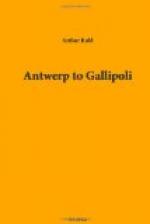Down the centre in the open carriages flows a stream of women—and many look like Nazimova—social distinctions so ironed out with enamel, paint, and powder that almost all might be cafe chantant singers or dressmakers’ marionettes. Some cities have eagles on their crests, and some volcanoes. If you were going to design a postage-stamp for Bucarest, it struck me that the natural thing would be a woman in the corner of an open victoria—after seeing scores of them all alike, you feel as though you could do it in a minute: one slashing line for the hat, two coal-black holes, and a dash of carmine in a patch of marble white, and a pair of silk-covered ankles crossed and pointed in a way that seems Parisian enough after one has become used to the curious boxes in which women enclose their feet in Berlin. Coming up from Bulgaria, which is not unlike coming from Idaho or Montana; or from Turkey, where women as something to be seen of men in public do not exist; or even across from the simple plains of Hungary, these enamelled orchids flowing forever down the asphalt seem at the moment to sum up the place—they are Bucarest.
Officers in light blue, in mauve and maroon—mincing butterflies, who look as if an hour’s march in the sun would send them to the hospital, ogle them from the sidewalk. Along with them are many young bloods out of uniform, barbered and powdered like chorus men made up for their work. You will see few young men in Europe with whom the notion of general conscription and the horrors of war can be associated with less regret.
Streams of more frugal nymphs, without victorias but with the same rakish air, push along with the sidewalk crowd, hats pinned like a wafer over one ear, coiffures drawn trimly up from powdered necks. Waiters scurry about; the cafe tables, crowded in these days with politicians, amateur diplomats, spies, ammunition agents, Heaven knows what, push out on the sidewalk. The people on the sidewalk are crowded into the street, motors honk, hoofs clatter, the air is filled with automobile smoke, the smoke carries the smell of cigarettes and coffee and women’s perfumes—it is “Bucarest joyeux!”
Some French music-hall singer—when I came through it was Miss Nita-Jo— will tell you all about it at one of the open-air theatres in the evening. All about the people you bump into in this sunset promenade—
“Des gens d’la haute, des petits creves, Des snobs, des sportsmans, des coquets, Les noctambules, les vieux noceurs, Les grandes cocottes—oui! tous en choeur...”—all about Capsa’s, which, though but a little pastry shop and tea-room, is as seriously regarded in Bucarest as Delmonico’s or the Blackstone, which is, of course, with dreadful seriousness (to see one of the gilded youths of Bucarest enter Capsa’s at five-thirty, solemnly devour a large chocolate eclair, and as solemnly stalk out again, is an experience itself), and all about the politicians and the men who are running things.




